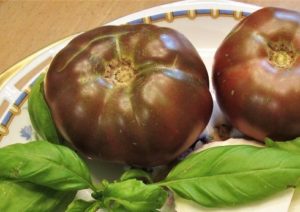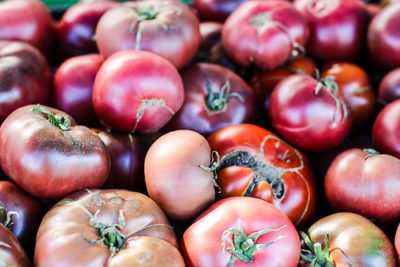updated 2/18/2024

‘Cherokee Purple’ tomatoes from my garden.
The Last of the ‘Cherokee Purple’
One of the most popular tomatoes offered at farmers’ markets is an heirloom called ‘Cherokee Purple’. We rarely see them in grocery stores because they don’t travel well over long distances. At the markets where I sell several heirloom tomato transplants, customers request this one most often.
In 1990, Craig LeHoullier, chemist and grower of hundreds of heirloom tomatoes near Raleigh NC, received unnamed tomato seeds and a note in the mail. John D. Green, of Sevierville TN, sent the material. Green received seeds that had been saved and passed among a few generations of local gardeners. His note said the Cherokee Indians in the area had been growing this lobed variety since the late 1800’s.
LeHoullier planted the seeds in 1991. Confident in this tomato’s marketable qualities—and naming it—he distributed seeds saved from the trial to Jeff McCormack of Southern Exposure Seed Exchange and to Rob Johnston of Johnny’s Selected Seeds. Beginning in 1993, these seed suppliers included the ‘Cherokee Purple’ tomato in their catalogs.
LeHoullier continued selecting variants of this variety, coming up with ‘Cherokee Green’ in 1997. This tomato is striped green and yellow, and has some orange tints at the blossom end of fully ripe fruits. After trialing a batch of seeds sent from another grower, Lehoullier named this one ‘Cherokee Chocolate’ in 1995. This variety is mahogany brown.
Attributes of the ‘Cherokee Purple’ Tomato
Often called “ugly” by some (not me), their flavor, nevertheless, is outstanding! The 8–12-ounce tomatoes might appear lumpy due to asymmetrical ribbing, but they’re often shaped like regular tomatoes.
The skin color is uniquely brick red to maroon, perhaps brownish, and often with green shoulders. The interior is also variably red to purple, sometimes with green.
When exposed to dappled sunlight, the fruits darken. The deeper “black” color indicates higher levels of beneficial antioxidants called anthocyanins. I prefer these super-nutrient fruits and vegetables, from red lettuces to blueberries to black tomatoes. A diet rich in antioxidants can help protect us from many kinds of cancer, inflammatory, and cardiovascular illnesses.
‘Cherokee Purple’ is shorter than most indeterminate tomatoes, staying around 5′ in height when staked. For tomato lovers without gardens, try growing it in a large container. It doesn’t bear as many fruits as some, such as ‘Black Prince’, but yields—and flavor— are sufficient to merit including it in your garden.
Because this variety developed in a naturally humid region of eastern United States, it probably has some disease resistance built into its genetics. In my experience, it’s less susceptible to disease than many other heirlooms.
As an heirloom tomato and not a hybrid, ‘Cherokee Purple’ is open-pollinated. So, you can save seeds from ripe fruits for next year’s garden. The offspring will be identical—or nearly so—to the parent plant.

“Mmmm… BLT”
There is no sandwich, burger, or salad that isn’t enhanced by adding this richly flavored tomato. Some call it smoky, while others consider it sweet, complex, or balanced. Try a “sloppy BLT” on lightly toasted rye with a fair amount of Duke’s mayonnaise (on both slices), bacon, lettuce, and this tomato, of course, but also with cheese and ripe avocado.
It is juicier than many other tomatoes and, therefore, is not recommended for sauce. But, if I have some ripe fruits, I’ll add them to the stock pot when making sauce, which simmers on low for 2 hours or longer.
Regardless how it’s described, the ‘Cherokee Purple’ tomato always has a place in my garden. In fact, when cool weather arrives in autumn, I place large pieces of clear plastic raised over the plants to protect them from frost. For a little extra warmth, add a hot water bottle or a string of miniature incandescent Christmas lights to extend the season for a few more ripe fruits.
When a freeze threatens, pick all remaining full-size or nearly full-size tomatoes and let them ripen on the kitchen counter. Be careful not to bruise them.
A few other varieties also get covered in the garden to give the fruits additional time to ripen, but it’s these last ‘Cherokee Purple’ tomatoes that wrap up the season.